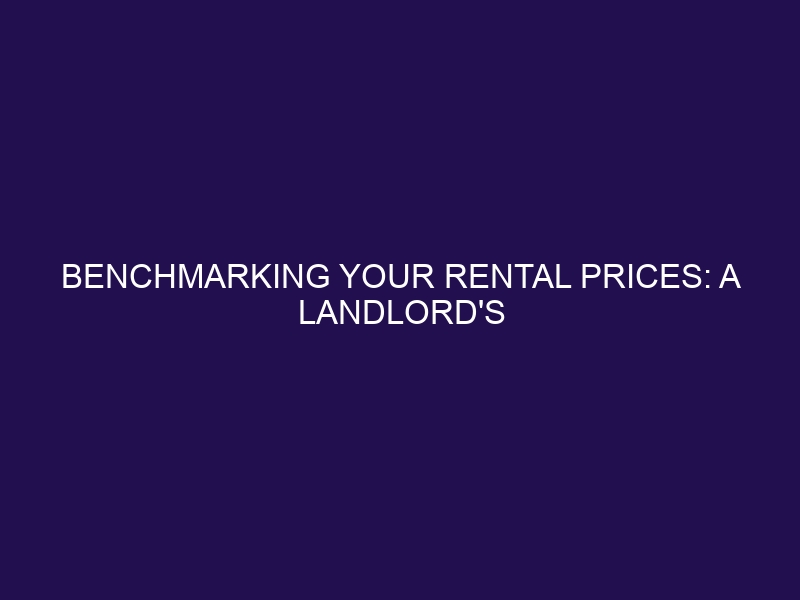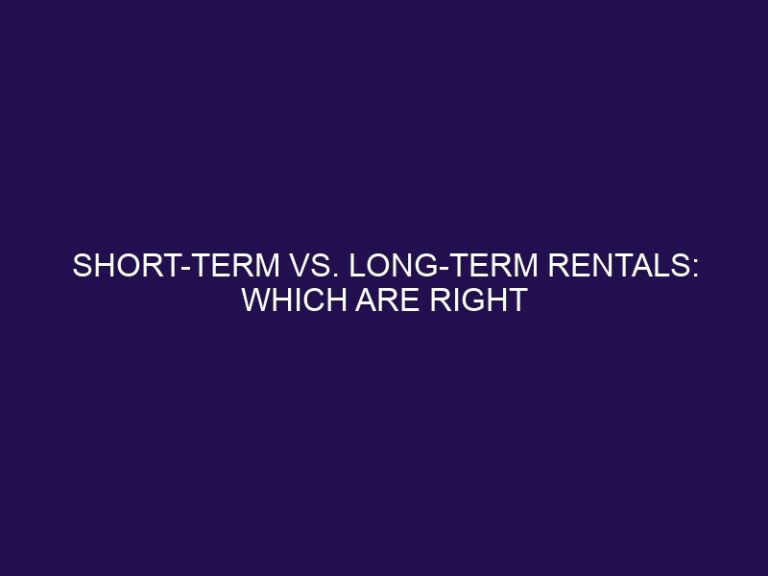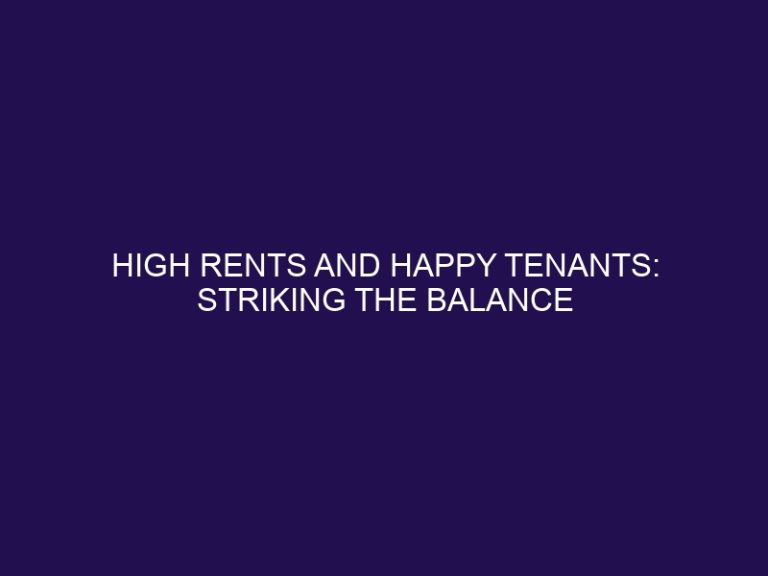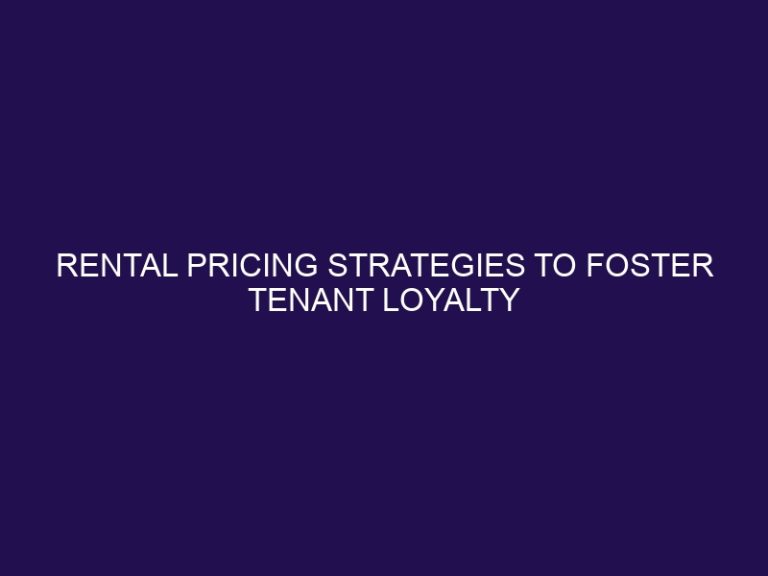Benchmarking Your Rental Prices: A Landlord’s Guide
Benchmarking rental prices is the process of comparing the rental prices of similar properties in a particular area to determine the fair market value for a rental property. It is an essential step for landlords as it helps them set competitive prices and attract potential tenants. In today’s competitive rental market, it is crucial for landlords to optimize their rental prices to attract and retain quality tenants.
As a landlord, benchmarking rental prices is important because it allows you to:
- Stay competitive in the market and attract potential tenants.
- Ensure your rental prices are fair and reasonable for both you and your tenants.
- Maximize your rental income and achieve a higher return on investment.
- Keep up with local market trends and adjust your prices accordingly.
To benchmark rental prices, landlords can follow these steps:
- Research local market trends and rental prices in the area.
- Compare similar properties to determine the average rental price.
- Consider the amenities and upgrades offered in the property.
When setting rental prices, landlords should consider various factors such as location, property size and layout, condition of the property, demand and supply in the area, and tenant demographics. Failure to consider these factors can result in setting prices too high or too low, which can lead to difficulties in finding suitable tenants or missed opportunities for maximizing profits.
Some common mistakes landlords make when setting rental prices include not considering local market trends, setting prices based on personal preferences rather than market demand, and not factoring in expenses and profit margins. To avoid these mistakes, landlords should regularly review and analyze market trends, seek tenant feedback, and ensure their rental prices cover expenses and allow for a reasonable profit margin.
Adjusting rental prices over time is necessary to keep up with market fluctuations and maintain a competitive edge. Landlords can do this by regularly reviewing and analyzing market trends, taking tenant feedback into consideration, offering incentives or discounts, and renovating or upgrading the property. By regularly benchmarking rental prices and adjusting them accordingly, landlords can ensure their properties are attractive to potential tenants and achieve a higher return on investment.
What Is Benchmarking Rental Prices?
What Is Benchmarking Rental Prices?
Benchmarking rental prices is the process of assessing your property’s rental rates in relation to other properties of similar location, size, and amenities. This evaluation allows landlords to establish competitive rental prices that accurately reflect the current market value and appeal to potential tenants.
Why Is Benchmarking Rental Prices Important for Landlords?
Why Is Benchmarking Rental Prices Important for Landlords?
Benchmarking rental prices is essential for landlords to remain competitive, increase profits, and attract high-quality tenants. It guarantees that rents are in line with current market rates, maximizing occupancy and income. Through analyzing similar properties, landlords can establish fair prices while providing value to their tenants.
How Can Landlords Benchmark Their Rental Prices?
As a landlord, setting the right rental price for your property is crucial for attracting and retaining tenants. But with so many factors to consider, it can be challenging to determine the best price. This is where benchmarking comes in. In this section, we will discuss the various ways landlords can benchmark their rental prices to ensure they are competitive and fair. From researching local market trends to comparing similar properties and considering amenities and upgrades, we will cover all the essential steps for effective price benchmarking.
1. Researching Local Market Trends
- Conduct thorough research on local rental market reports and databases.
- Analyze rental price trends in the neighborhood to gain a better understanding of the market.
- Seek insights from real estate agents and property management companies to further enhance your knowledge.
2. Comparing Similar Properties in the Area
| Property | Location | Size | Condition | Rental Price |
| Apartment A | City Center | 2 bedrooms | Good | $1500 |
| Apartment B | Suburb | 2 bedrooms | Excellent | $1600 |
| House C | Rural Area | 3 bedrooms | Fair | $1200 |
Pro-tip: Consider the property’s proximity to essential amenities for accurate comparisons.
2. Comparing Similar Properties in the Area
3. Considering Amenities and Upgrades
- Research the amenities and upgrades in similar properties.
- Assess the impact of amenities and upgrades on rental prices.
- Consider the preferences of target tenants when adding amenities and upgrades.
When considering amenities and upgrades for rental properties, it is important to prioritize features that will add value and appeal to potential tenants. This will help justify any potential increase in rental prices while also catering to the preferences of your target tenants.
What Factors Should Landlords Consider When Setting Rental Prices?
Setting the right rental price for your property is crucial for attracting and retaining tenants while also maximizing your profits. However, with so many factors to consider, it can be a daunting task for landlords. In this section, we will dive into the key factors that landlords should take into account when setting rental prices. From location and size to demand and tenant demographics, we will explore how each of these elements can impact the rental value of your property.
1. Location
- Evaluate the proximity to amenities and transportation.
- Assess the neighborhood’s safety and crime rates.
- Consider the potential for future development and growth in the location.
- Analyze the desirability of the location for the target tenant demographic.
2. Size and Layout
-
Assess property size and layout in comparison to similar rentals in the area.
-
Consider the number of bedrooms, bathrooms, and overall square footage.
-
Factor in any unique features, such as a patio or additional storage space.
3. Condition of Property
- Inspect the property for any damages, wear and tear, or need for repairs.
- Assess the overall cleanliness and hygiene of the property.
- Evaluate the age and condition of appliances, fixtures, and fittings.
- Consider the functionality and aesthetics of the property’s interior and exterior.
Ensuring the property’s condition is well-maintained and aesthetically appealing can have a positive impact on rental prices.
4. Demand and Supply in the Area
In order to determine rental prices, landlords must carefully evaluate the demand and supply within the area. This involves conducting research on local market trends and analyzing the demographics of potential tenants to gain a better understanding of the rental market. Furthermore, it is important to compare similar properties and consider the dynamics of demand and supply in order to establish competitive rental prices.
5. Tenant Demographics
- Analyze tenant demographics to gain insights into income levels, family size, and occupation.
- Take into account factors such as age, lifestyle, and cultural background to personalize rental offerings.
- Leverage demographic data to develop targeted marketing strategies and customize properties.
What Are Some Common Mistakes Landlords Make When Setting Rental Prices?
Setting the right rental price for your property can be a challenging task, and many landlords make common mistakes that can impact their bottom line. In this section, we will discuss the most frequent mistakes landlords make when setting rental prices. From not keeping up with local market trends to setting prices too high or too low, these errors can have a significant impact on your rental business. We will also explore the importance of factoring in expenses and profit margins to ensure a successful and sustainable rental venture.
1. Not Considering Local Market Trends
- Research local market trends by analyzing rental prices, vacancy rates, and property appreciation.
- Attend local real estate meetings, network with other landlords, and consult with real estate agents to gain insights into current market trends.
- Utilize online platforms and tools to track rental price changes in the local area and stay updated on market trends.
True story: A landlord overlooked the importance of considering local market trends and set rental prices based on outdated information. As a result, their properties remained vacant for an extended period, leading to financial loss and increased competition in the area.
2. Setting Prices Too High or Too Low
- Conduct thorough market research to gauge competitive rental rates.
- Consider property condition, amenities, and location when pricing.
- Regularly adjust prices based on market demand and tenant feedback.
- Seek professional advice to ensure optimal pricing strategy.
Ensure your rental prices reflect market dynamics and property value to avoid setting prices too high or too low, which could negatively impact your ability to attract and retain tenants.
3. Not Factoring in Expenses and Profit Margins
- When setting rental prices, it’s crucial to thoroughly evaluate expenses and profit margins to ensure a sustainable and lucrative investment.
- Calculate all property-related costs, including maintenance, repairs, and property management fees.
- Estimate potential vacancies and factor in a financial cushion for unexpected expenses.
- Analyze market price trends and determine a competitive yet profitable rental rate.
Don’t make the mistake of not factoring in expenses and profit margins when setting rental prices. It’s important to carefully consider all costs and potential profits to ensure a successful investment.
How Can Landlords Adjust Rental Prices Over Time?
As a landlord, one of the key responsibilities is setting and adjusting rental prices for your properties. But how can landlords ensure they are charging a fair rate that attracts tenants while also maximizing profits? In this section, we will discuss various strategies for adjusting rental prices over time. From regularly reviewing market trends to offering incentives, we will explore different ways landlords can make informed decisions about rental prices.
1. Regularly Reviewing and Analyzing Market Trends
- Stay informed about market trends by regularly subscribing to industry publications and attending real estate seminars.
- Analyze rental price data from credible sources, such as government housing reports or professional associations.
- Utilize online tools and platforms to monitor rental prices and fluctuations in demand in the local area.
2. Making Adjustments Based on Tenant Feedback
- Regularly listen to tenant concerns and suggestions.
- Implement necessary changes based on valid feedback to enhance tenant satisfaction.
- Consider conducting surveys to gather comprehensive feedback on all aspects of the property.
By ensuring that tenant feedback is heard and acted upon, it can lead to improved tenant retention and a positive reputation for the rental property.
3. Offering Incentives or Discounts
- Consider offering temporary rent discounts for new tenants to entice them to choose your property.
- Provide referral bonuses for existing tenants who successfully bring in new renters, incentivizing them to spread the word about your property.
- Attract potential tenants by offering free amenities such as parking or gym access for a limited time.
Did you know that providing incentives or discounts can be an effective strategy for attracting and retaining quality tenants?
4. Renovating or Upgrading the Property
- Assess the property for any necessary renovations or upgrades.
- Identify areas in need of improvement such as the kitchen, bathroom, or curb appeal.
- Conduct research on cost-effective options for renovations.
- Consult with real estate professionals for advice on renovations.
- Implement renovations and upgrades based on budget and potential return on investment.
Frequently Asked Questions
What are the three steps involved in setting the right rental price?
The three steps involved in setting the right rental price are researching rental prices in the area, complying with rental laws, and considering tips for pricing a rental unit.
How important is it to regularly review and adjust rental prices?
Regularly reviewing and adjusting rental prices is crucial for achieving financial goals and attracting the right tenants. It allows landlords to stay competitive in the rental market and maximize investment returns.
What is a Rental Market Analysis (RMA) and how can it help landlords?
A Rental Market Analysis (RMA) is a tool used by real estate investors to determine a property’s income potential. It involves researching comparable rental properties, analyzing local amenities, and calculating average rental rates. It can help landlords make informed investment decisions and attract a high-quality tenant pool.
How can landlords figure out the true value of their rental property?
Landlords can figure out the true value of their rental property by conducting in-depth research, including a rental market forecast and meticulous examination of the property’s features and rental potential. They can also consult with rental experts for valuable insights and assistance.
What are some key factors that can affect rental prices?
Rental prices can be affected by a host of key factors, including the rental market forecast, property location, local amenities, property features, and tenant demands. It is important for landlords to carefully consider these factors when determining the rental price of their property.
How can landlords ensure their rental price is competitive and properly priced?
Landlords can ensure their rental price is competitive and properly priced by conducting a rental market analysis, carefully considering their property’s appeal, and regularly reviewing and making rent adjustments. They can also consult with rental experts and use online rent estimates for assistance.







